Non-Polarizing Beamsplitter Cubes in 30 mm Cage Cubes
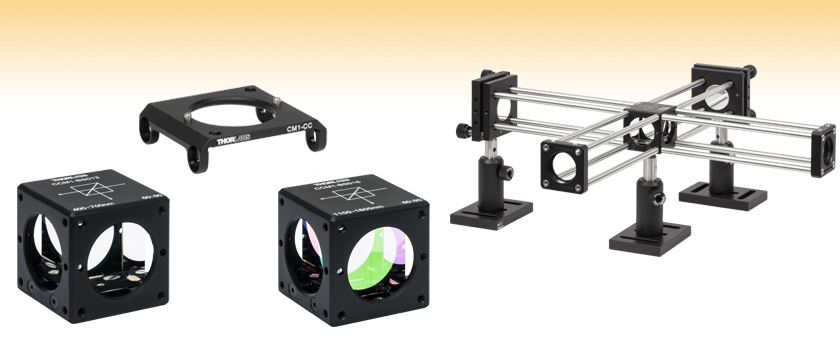
- 50:50 Split Ratio
- SM1 Lens Tube and 30 mm Cage System Compatible
- AR-Coated on All Four Optical Faces
CM1-CC
CCM1-BS013
400 - 700 nm
CCM1-BS015
1100 - 1600 nm
Application Idea
Cage Setup with KC1 Kinematic Mirror Mounts, a Non-Polarizing Beamsplitter Cube, and 30 mm Cage Plates

Please Wait
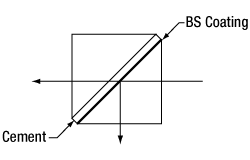
Cube Beamsplitter Diagram
(Coating and Cement Layer Not to Scale)
Features
- Three Wavelength Ranges Available
- 400 - 700 nm
- 700 - 1100 nm
- 1100 - 1600 nm
- 50:50 Split Ratio
- AR Coated on All Four Optical Faces
- Compatible with 30 mm Cage System and SM1-Threaded (1.035"-40) Components
- Connect Two Cage Cubes Side by Side with the CM1-CC Cage Cube Connector
Thorlabs’ 1" non-polarizing beamsplitter cubes are offered mounted for compatibility with 30 mm cage systems. These mounted cubes are available in three wavelength ranges: 400 - 700 nm, 700 - 1100 nm, 1100 - 1600 nm.
The dielectric beamsplitting coating is applied to the hypotenuse of one of the two prisms that make up the cube, and then cement is used to bind the two prism halves together (refer to the diagram to the right). Each face of the cube has a broadband antireflective coating that minimize losses due to reflections. The housing is engraved with arrows that indicate the direction in which the beam is incident on the beamsplitter coating layer, as shown in the diagram to the right. Although light can enter through any of the other AR-coated surfaces, specifications are guaranteed when light is first incident on the side of the beamsplitter coating; see the diagram to the right. Each beamsplitter cube is epoxied within the cage cube mount and cannot be removed from the mount. We also offer empty 30 mm cage cubes that are compatible with our line of unmounted beamsplitter cubes and right-angle prisms.
Thorlabs also offers two other types of mounted beamsplitters: Polarizing Beamsplitting Cubes and Pellicle Beamsplitters. A large variety of unmounted beamsplitters are also available. For a direct comparison of the performance of our non-polarizing cube, plate, and pellicle beamsplitters at 633 nm, please refer to the Lab Facts tab.
For a complete selection of our cube-mounted optics please see the Mounted Optics Guide tab.
| Item # | CCM1-BS013(/M) | CCM1-BS014(/M) | CCM1-BS015(/M) | |
|---|---|---|---|---|
| AR-Coating Range | 400 - 700 nm | 700 - 1100 nm | 1100 - 1600 nm | |
| Reflectance @ 0° AOI | Ravg<0.5% | Ravg<0.5% | Ravg<0.5% | |
| Split Ratio | 50:50 | |||
| Performance | Tabs= 47 ± 10%, Rabs= 47 ± 10%, Tabs + Rabs > 85%, Tavg + Ravg > 90%, |Ts - Tp| < 10%, and |Rs - Rp| < 10% |
Tabs= 47 ± 10%, Rabs= 47 ± 10%, Tabs + Rabs > 90%, |Ts - Tp| < 10%, and |Rs - Rp| < 10% |
Tabs= 47 ± 10%, Rabs= 47 ± 10%, Tabs + Rabs > 83%, Tavg + Ravg > 88%, |Ts - Tp| < 10%, and |Rs - Rp| < 10% |
|
| Ports | 4 Ports With SM1 (1.035"-40) Thread | |||
| Beamsplitter Material | N-BK7 - Grade A | |||
| Housing Material | Engraved Black Anodized Aluminum Housing | |||
| Transmitted Wavefront Error | λ/4 at 633 nm (rms) | |||
| Max Transmitted Beam Deviationa | ±5 arcmin | |||
| Reflected Beam Deviationb | 90° ± 20 arcmin | |||
| Clear Aperture | >Ø20.3 mm | |||
| Surface Quality | 40-20 Scratch-Dig | |||
| Damage Threshold | Pulsed | 0.25 J/cm2 (532 nm, 10 ns, 10 Hz, Ø0.341 mm) |
0.25 J/cm2 (810 nm, 10 ns, 10 Hz, Ø0.166 mm) |
0.25 J/cm2 (1542 nm, 10 ns, 10 Hz, Ø0.282 mm) |
| CWc | 50 W/cm (532 nm, Ø1.000 mm) |
10 W/cm (1070 nm, Ø1.012 mm) |
50 W/cm (1542 nm, Ø1.030 mm) |
|
The data below is relative to the power of the incident beam. Note that some light will be absorbed by the beamsplitter coating. The blue shaded regions denote the transmission and reflection bands for which the performance is guaranteed to meet the stated specifications. The data shown here is typical and run-to-run variations will occur within the given specifications. Performance outside the shaded regions is not guaranteed.
Thorlabs Lab Fact: Beamsplitter Package Matters
We present laboratory measurements of the polarization angle, split ratio, and total throughput power of a beam transmitted through Thorlabs plate, cube, and pellicle beamsplitters. While all non-polarizing beamsplitters function similarly, the exact performance is different for different types of beamsplitter. Each type of beamsplitter contains its own advantages and disadvantages compared to other types of beamsplitters. Appropriate choice of beamsplitter is essential to sensitive experimental systems. We present a complete analysis and comparison of optical parameters for three common types of non-polarizing beamsplitters.
For our experiment we used the former generation HRS015 stabilized HeNe laser (replaced by the HRS015B) as the light source for our investigation. A linear polarizer is used to set the laser beam's polarization axis to 45° in order to provide equal s- and p-polarized light incident on the beamsplitter. The beamsplitter under investigation was then placed in the beampath, and its split beams directed to appropriate detectors. The total power though the optic, polarization states, split ratios, and angle of incidence effects were investigated under this configuration.
The plots below summarize the measured results for all three types of beamsplitters. From these graphs the performance of each optic can be easily compared to one another. The bottom left plot summarizes the results for the total power throughput for each optic. The total power throughput is measured as the fraction of input power. While the plate and pellicle beamsplitters perform rather similarly, the cube shows signs of absorption inside the optic. Additionally, this plot shows the relative insensitivity of throughput power to angle of incidence. The bottom middle graph summarizes the results for the output polarization angle for each optic. The cube shows the most similar polarization angles between the reflected and transmitted beams, with the plate producing the largest difference in polarization between beams. The bottom right plot summarizes the results for the split ratio, as a fraction of input power, for the beamsplitters. Here it can be shown that the plate beamsplitter demonstrates the most ideal for 50/50 power splitting. For details on the experimental setup employed and the results summarized here, please click here.
| Damage Threshold Specifications | ||
|---|---|---|
| Item # | Laser Type | Damage Threshold |
| CCM1-BS013(/M) | Pulsed | 0.25 J/cm2 (532 nm, 10 ns, 10 Hz, Ø0.341 mm) |
| CWa | 50 W/cm (532 nm, Ø1.000 mm) | |
| CCM1-BS014(/M) | Pulsed | 0.25 J/cm2 (810 nm, 10 ns, 10 Hz, Ø0.166 mm) |
| CWa | 10 W/cm (1070 nm, Ø1.012 mm) | |
| CCM1-BS015(/M) | Pulsed | 0.25 J/cm2 (1542 nm, 10 ns, 10 Hz, Ø0.282 mm) |
| CWa | 50 W/cm (1542 nm, Ø1.030 mm) | |
Damage Threshold Data for Thorlabs' Non-Polarizing Cube Beamsplitters
The specifications to the right are measured data for Thorlabs' non-polarizing cube beamsplitters. Damage threshold specifications are constant for all cubes that use the same coatings, regardless of the size of the beamsplitter.
Laser Induced Damage Threshold Tutorial
The following is a general overview of how laser induced damage thresholds are measured and how the values may be utilized in determining the appropriateness of an optic for a given application. When choosing optics, it is important to understand the Laser Induced Damage Threshold (LIDT) of the optics being used. The LIDT for an optic greatly depends on the type of laser you are using. Continuous wave (CW) lasers typically cause damage from thermal effects (absorption either in the coating or in the substrate). Pulsed lasers, on the other hand, often strip electrons from the lattice structure of an optic before causing thermal damage. Note that the guideline presented here assumes room temperature operation and optics in new condition (i.e., within scratch-dig spec, surface free of contamination, etc.). Because dust or other particles on the surface of an optic can cause damage at lower thresholds, we recommend keeping surfaces clean and free of debris. For more information on cleaning optics, please see our Optics Cleaning tutorial.
Testing Method
Thorlabs' LIDT testing is done in compliance with ISO/DIS 11254 and ISO 21254 specifications.
First, a low-power/energy beam is directed to the optic under test. The optic is exposed in 10 locations to this laser beam for 30 seconds (CW) or for a number of pulses (pulse repetition frequency specified). After exposure, the optic is examined by a microscope (~100X magnification) for any visible damage. The number of locations that are damaged at a particular power/energy level is recorded. Next, the power/energy is either increased or decreased and the optic is exposed at 10 new locations. This process is repeated until damage is observed. The damage threshold is then assigned to be the highest power/energy that the optic can withstand without causing damage. A histogram such as that below represents the testing of one BB1-E02 mirror.

The photograph above is a protected aluminum-coated mirror after LIDT testing. In this particular test, it handled 0.43 J/cm2 (1064 nm, 10 ns pulse, 10 Hz, Ø1.000 mm) before damage.

| Example Test Data | |||
|---|---|---|---|
| Fluence | # of Tested Locations | Locations with Damage | Locations Without Damage |
| 1.50 J/cm2 | 10 | 0 | 10 |
| 1.75 J/cm2 | 10 | 0 | 10 |
| 2.00 J/cm2 | 10 | 0 | 10 |
| 2.25 J/cm2 | 10 | 1 | 9 |
| 3.00 J/cm2 | 10 | 1 | 9 |
| 5.00 J/cm2 | 10 | 9 | 1 |
According to the test, the damage threshold of the mirror was 2.00 J/cm2 (532 nm, 10 ns pulse, 10 Hz, Ø0.803 mm). Please keep in mind that these tests are performed on clean optics, as dirt and contamination can significantly lower the damage threshold of a component. While the test results are only representative of one coating run, Thorlabs specifies damage threshold values that account for coating variances.
Continuous Wave and Long-Pulse Lasers
When an optic is damaged by a continuous wave (CW) laser, it is usually due to the melting of the surface as a result of absorbing the laser's energy or damage to the optical coating (antireflection) [1]. Pulsed lasers with pulse lengths longer than 1 µs can be treated as CW lasers for LIDT discussions.
When pulse lengths are between 1 ns and 1 µs, laser-induced damage can occur either because of absorption or a dielectric breakdown (therefore, a user must check both CW and pulsed LIDT). Absorption is either due to an intrinsic property of the optic or due to surface irregularities; thus LIDT values are only valid for optics meeting or exceeding the surface quality specifications given by a manufacturer. While many optics can handle high power CW lasers, cemented (e.g., achromatic doublets) or highly absorptive (e.g., ND filters) optics tend to have lower CW damage thresholds. These lower thresholds are due to absorption or scattering in the cement or metal coating.

LIDT in linear power density vs. pulse length and spot size. For long pulses to CW, linear power density becomes a constant with spot size. This graph was obtained from [1].

Pulsed lasers with high pulse repetition frequencies (PRF) may behave similarly to CW beams. Unfortunately, this is highly dependent on factors such as absorption and thermal diffusivity, so there is no reliable method for determining when a high PRF laser will damage an optic due to thermal effects. For beams with a high PRF both the average and peak powers must be compared to the equivalent CW power. Additionally, for highly transparent materials, there is little to no drop in the LIDT with increasing PRF.
In order to use the specified CW damage threshold of an optic, it is necessary to know the following:
- Wavelength of your laser
- Beam diameter of your beam (1/e2)
- Approximate intensity profile of your beam (e.g., Gaussian)
- Linear power density of your beam (total power divided by 1/e2 beam diameter)
Thorlabs expresses LIDT for CW lasers as a linear power density measured in W/cm. In this regime, the LIDT given as a linear power density can be applied to any beam diameter; one does not need to compute an adjusted LIDT to adjust for changes in spot size, as demonstrated by the graph to the right. Average linear power density can be calculated using the equation below.

The calculation above assumes a uniform beam intensity profile. You must now consider hotspots in the beam or other non-uniform intensity profiles and roughly calculate a maximum power density. For reference, a Gaussian beam typically has a maximum power density that is twice that of the uniform beam (see lower right).
Now compare the maximum power density to that which is specified as the LIDT for the optic. If the optic was tested at a wavelength other than your operating wavelength, the damage threshold must be scaled appropriately. A good rule of thumb is that the damage threshold has a linear relationship with wavelength such that as you move to shorter wavelengths, the damage threshold decreases (i.e., a LIDT of 10 W/cm at 1310 nm scales to 5 W/cm at 655 nm):

While this rule of thumb provides a general trend, it is not a quantitative analysis of LIDT vs wavelength. In CW applications, for instance, damage scales more strongly with absorption in the coating and substrate, which does not necessarily scale well with wavelength. While the above procedure provides a good rule of thumb for LIDT values, please contact Tech Support if your wavelength is different from the specified LIDT wavelength. If your power density is less than the adjusted LIDT of the optic, then the optic should work for your application.
Please note that we have a buffer built in between the specified damage thresholds online and the tests which we have done, which accommodates variation between batches. Upon request, we can provide individual test information and a testing certificate. The damage analysis will be carried out on a similar optic (customer's optic will not be damaged). Testing may result in additional costs or lead times. Contact Tech Support for more information.
Pulsed Lasers
As previously stated, pulsed lasers typically induce a different type of damage to the optic than CW lasers. Pulsed lasers often do not heat the optic enough to damage it; instead, pulsed lasers produce strong electric fields capable of inducing dielectric breakdown in the material. Unfortunately, it can be very difficult to compare the LIDT specification of an optic to your laser. There are multiple regimes in which a pulsed laser can damage an optic and this is based on the laser's pulse length. The highlighted columns in the table below outline the relevant pulse lengths for our specified LIDT values.
Pulses shorter than 10-9 s cannot be compared to our specified LIDT values with much reliability. In this ultra-short-pulse regime various mechanics, such as multiphoton-avalanche ionization, take over as the predominate damage mechanism [2]. In contrast, pulses between 10-7 s and 10-4 s may cause damage to an optic either because of dielectric breakdown or thermal effects. This means that both CW and pulsed damage thresholds must be compared to the laser beam to determine whether the optic is suitable for your application.
| Pulse Duration | t < 10-9 s | 10-9 < t < 10-7 s | 10-7 < t < 10-4 s | t > 10-4 s |
|---|---|---|---|---|
| Damage Mechanism | Avalanche Ionization | Dielectric Breakdown | Dielectric Breakdown or Thermal | Thermal |
| Relevant Damage Specification | No Comparison (See Above) | Pulsed | Pulsed and CW | CW |
When comparing an LIDT specified for a pulsed laser to your laser, it is essential to know the following:

LIDT in energy density vs. pulse length and spot size. For short pulses, energy density becomes a constant with spot size. This graph was obtained from [1].
- Wavelength of your laser
- Energy density of your beam (total energy divided by 1/e2 area)
- Pulse length of your laser
- Pulse repetition frequency (prf) of your laser
- Beam diameter of your laser (1/e2 )
- Approximate intensity profile of your beam (e.g., Gaussian)
The energy density of your beam should be calculated in terms of J/cm2. The graph to the right shows why expressing the LIDT as an energy density provides the best metric for short pulse sources. In this regime, the LIDT given as an energy density can be applied to any beam diameter; one does not need to compute an adjusted LIDT to adjust for changes in spot size. This calculation assumes a uniform beam intensity profile. You must now adjust this energy density to account for hotspots or other nonuniform intensity profiles and roughly calculate a maximum energy density. For reference a Gaussian beam typically has a maximum energy density that is twice that of the 1/e2 beam.
Now compare the maximum energy density to that which is specified as the LIDT for the optic. If the optic was tested at a wavelength other than your operating wavelength, the damage threshold must be scaled appropriately [3]. A good rule of thumb is that the damage threshold has an inverse square root relationship with wavelength such that as you move to shorter wavelengths, the damage threshold decreases (i.e., a LIDT of 1 J/cm2 at 1064 nm scales to 0.7 J/cm2 at 532 nm):

You now have a wavelength-adjusted energy density, which you will use in the following step.
Beam diameter is also important to know when comparing damage thresholds. While the LIDT, when expressed in units of J/cm², scales independently of spot size; large beam sizes are more likely to illuminate a larger number of defects which can lead to greater variances in the LIDT [4]. For data presented here, a <1 mm beam size was used to measure the LIDT. For beams sizes greater than 5 mm, the LIDT (J/cm2) will not scale independently of beam diameter due to the larger size beam exposing more defects.
The pulse length must now be compensated for. The longer the pulse duration, the more energy the optic can handle. For pulse widths between 1 - 100 ns, an approximation is as follows:

Use this formula to calculate the Adjusted LIDT for an optic based on your pulse length. If your maximum energy density is less than this adjusted LIDT maximum energy density, then the optic should be suitable for your application. Keep in mind that this calculation is only used for pulses between 10-9 s and 10-7 s. For pulses between 10-7 s and 10-4 s, the CW LIDT must also be checked before deeming the optic appropriate for your application.
Please note that we have a buffer built in between the specified damage thresholds online and the tests which we have done, which accommodates variation between batches. Upon request, we can provide individual test information and a testing certificate. Contact Tech Support for more information.
[1] R. M. Wood, Optics and Laser Tech. 29, 517 (1998).
[2] Roger M. Wood, Laser-Induced Damage of Optical Materials (Institute of Physics Publishing, Philadelphia, PA, 2003).
[3] C. W. Carr et al., Phys. Rev. Lett. 91, 127402 (2003).
[4] N. Bloembergen, Appl. Opt. 12, 661 (1973).
In order to illustrate the process of determining whether a given laser system will damage an optic, a number of example calculations of laser induced damage threshold are given below. For assistance with performing similar calculations, we provide a spreadsheet calculator that can be downloaded by clicking the button to the right. To use the calculator, enter the specified LIDT value of the optic under consideration and the relevant parameters of your laser system in the green boxes. The spreadsheet will then calculate a linear power density for CW and pulsed systems, as well as an energy density value for pulsed systems. These values are used to calculate adjusted, scaled LIDT values for the optics based on accepted scaling laws. This calculator assumes a Gaussian beam profile, so a correction factor must be introduced for other beam shapes (uniform, etc.). The LIDT scaling laws are determined from empirical relationships; their accuracy is not guaranteed. Remember that absorption by optics or coatings can significantly reduce LIDT in some spectral regions. These LIDT values are not valid for ultrashort pulses less than one nanosecond in duration.

A Gaussian beam profile has about twice the maximum intensity of a uniform beam profile.
CW Laser Example
Suppose that a CW laser system at 1319 nm produces a 0.5 W Gaussian beam that has a 1/e2 diameter of 10 mm. A naive calculation of the average linear power density of this beam would yield a value of 0.5 W/cm, given by the total power divided by the beam diameter:

However, the maximum power density of a Gaussian beam is about twice the maximum power density of a uniform beam, as shown in the graph to the right. Therefore, a more accurate determination of the maximum linear power density of the system is 1 W/cm.
An AC127-030-C achromatic doublet lens has a specified CW LIDT of 350 W/cm, as tested at 1550 nm. CW damage threshold values typically scale directly with the wavelength of the laser source, so this yields an adjusted LIDT value:

The adjusted LIDT value of 350 W/cm x (1319 nm / 1550 nm) = 298 W/cm is significantly higher than the calculated maximum linear power density of the laser system, so it would be safe to use this doublet lens for this application.
Pulsed Nanosecond Laser Example: Scaling for Different Pulse Durations
Suppose that a pulsed Nd:YAG laser system is frequency tripled to produce a 10 Hz output, consisting of 2 ns output pulses at 355 nm, each with 1 J of energy, in a Gaussian beam with a 1.9 cm beam diameter (1/e2). The average energy density of each pulse is found by dividing the pulse energy by the beam area:

As described above, the maximum energy density of a Gaussian beam is about twice the average energy density. So, the maximum energy density of this beam is ~0.7 J/cm2.
The energy density of the beam can be compared to the LIDT values of 1 J/cm2 and 3.5 J/cm2 for a BB1-E01 broadband dielectric mirror and an NB1-K08 Nd:YAG laser line mirror, respectively. Both of these LIDT values, while measured at 355 nm, were determined with a 10 ns pulsed laser at 10 Hz. Therefore, an adjustment must be applied for the shorter pulse duration of the system under consideration. As described on the previous tab, LIDT values in the nanosecond pulse regime scale with the square root of the laser pulse duration:

This adjustment factor results in LIDT values of 0.45 J/cm2 for the BB1-E01 broadband mirror and 1.6 J/cm2 for the Nd:YAG laser line mirror, which are to be compared with the 0.7 J/cm2 maximum energy density of the beam. While the broadband mirror would likely be damaged by the laser, the more specialized laser line mirror is appropriate for use with this system.
Pulsed Nanosecond Laser Example: Scaling for Different Wavelengths
Suppose that a pulsed laser system emits 10 ns pulses at 2.5 Hz, each with 100 mJ of energy at 1064 nm in a 16 mm diameter beam (1/e2) that must be attenuated with a neutral density filter. For a Gaussian output, these specifications result in a maximum energy density of 0.1 J/cm2. The damage threshold of an NDUV10A Ø25 mm, OD 1.0, reflective neutral density filter is 0.05 J/cm2 for 10 ns pulses at 355 nm, while the damage threshold of the similar NE10A absorptive filter is 10 J/cm2 for 10 ns pulses at 532 nm. As described on the previous tab, the LIDT value of an optic scales with the square root of the wavelength in the nanosecond pulse regime:

This scaling gives adjusted LIDT values of 0.08 J/cm2 for the reflective filter and 14 J/cm2 for the absorptive filter. In this case, the absorptive filter is the best choice in order to avoid optical damage.
Pulsed Microsecond Laser Example
Consider a laser system that produces 1 µs pulses, each containing 150 µJ of energy at a repetition rate of 50 kHz, resulting in a relatively high duty cycle of 5%. This system falls somewhere between the regimes of CW and pulsed laser induced damage, and could potentially damage an optic by mechanisms associated with either regime. As a result, both CW and pulsed LIDT values must be compared to the properties of the laser system to ensure safe operation.
If this relatively long-pulse laser emits a Gaussian 12.7 mm diameter beam (1/e2) at 980 nm, then the resulting output has a linear power density of 5.9 W/cm and an energy density of 1.2 x 10-4 J/cm2 per pulse. This can be compared to the LIDT values for a WPQ10E-980 polymer zero-order quarter-wave plate, which are 5 W/cm for CW radiation at 810 nm and 5 J/cm2 for a 10 ns pulse at 810 nm. As before, the CW LIDT of the optic scales linearly with the laser wavelength, resulting in an adjusted CW value of 6 W/cm at 980 nm. On the other hand, the pulsed LIDT scales with the square root of the laser wavelength and the square root of the pulse duration, resulting in an adjusted value of 55 J/cm2 for a 1 µs pulse at 980 nm. The pulsed LIDT of the optic is significantly greater than the energy density of the laser pulse, so individual pulses will not damage the wave plate. However, the large average linear power density of the laser system may cause thermal damage to the optic, much like a high-power CW beam.
30 mm Cage-Cube-Mounted Optics Selection Guide
The table below provides links to all of our 30 mm Cage-Cube-Mounted optics. For our selection of 16 mm Cage-Cube-Mounted Optics, please see our 16 mm Cage Systems guide.
30 mm Cage Cube Empty Optic Mounts Selection Guide
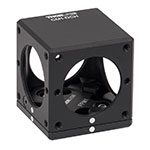 |
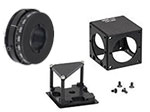 |
| Rectangular Dichroic Mirrors and Filters | Empty Compact 30 mm Cage Cube |
| Posted Comments: | |
Shalika Singh
(posted 2024-10-30 09:46:06.86) Hi, I wish to calibrate all faces of BS for my setup. I will mount it on a magnetic/rotating mount. Will the BS move inside if I flip by 90 or 180 deg or in general when I move? user
(posted 2024-10-08 10:37:33.063) Hi,
One of our beamsplitter cubes has detached from the bottom of the cage (unfortunately, a grub screw was tightened to far in to the bottom of the cage, causing the cube to detach).
We would like to glue the cube back to the cage, what is the best adhesive to use? mgarodia
(posted 2024-10-11 12:41:26.0) Thank you for reaching out to us. We use a specific epoxy for this purpose and would recommend that you send this back to us for repair. We have reached out to you directly regarding this. marc fleury
(posted 2023-08-28 18:58:15.853) Hello,
I actually have a question about the phase delay introduced on the reflected beam. Am I correct in thinking the S polarized is un-affected but that the P polarized experiences a 180 phase delay?
Thank in advance. cdolbashian
(posted 2023-08-30 01:12:16.0) Thank you for reaching out to us with this inquiry. Unfortunately, we do not have such phase delay data to share. Jeremy Mularski
(posted 2022-01-03 13:42:59.607) Same question, as I saw in feedback section on 9/4/2020. Is the ratio 50:50 very degraded if the incident light comes from the top (wrt your figure) and goes by the back of the coated surface? cdolbashian
(posted 2022-01-04 10:48:51.0) Thank you for reaching out to us at Thorlabs with this inquiry! When the previous customer inquired about this on 9/4/2020, we tested the transmission and reflection with the cube in both orientations. While the transmission was nominally the same, the reflected light in the alternative configuration (light entering from the "top" with respect to our drawing), was slightly attenuated due to the extra interface layer of cement. I have emailed you directly to discuss this further. Nelson de Gaay Fortman
(posted 2021-10-27 07:47:11.833) What is the width of the cement layer, and of the AR coating? And what materials (refractive index) are used for the cement layer, and the AR coating? Have you seen etaloning effects in this beamsplitter? YLohia
(posted 2021-12-23 11:10:54.0) Thank you for contacting Thorlabs. We have reached out to you directly to discuss this further. Jul JJ
(posted 2020-09-04 06:52:55.323) Is the ratio 50:50 very degraded if the incident light comes from the top (wrt your figure) and goes by the back of the coated surface? YLohia
(posted 2020-09-10 08:47:18.0) Thank you for contacting Thorlabs. We will reach out to you directly with some data. Niall Martin
(posted 2020-05-07 06:24:42.097) I think there may be a drawing issue on the drawing for CCM1-BS013/M
The note on the 4-40 holes states
"#4-40 TAPPED HOLES ON 16mm CENTERS
ON ALL FOUR SIDES FOR MOUNTING INTO
THORLABS 30.0mm CAGE SYSTEM"
but the dimension states 15mm centres and the CAD also seems to show 15mm centres
I think 15mm centres is correct. Could someone confirm this for me. You may also need to up-issue your drawing YLohia
(posted 2020-05-07 10:54:11.0) Thank you for contacting Thorlabs and bringing this to our attention. The #4-40 taps are spaced 30 mm apart (not 15 mm or 16 mm). We will correct this typo. marioncromb
(posted 2018-08-15 15:38:04.0) I am using the BS013 in a Michelson interferometer setup. When both arms are blocked, I still see some light in the output. I assume this is from reflection from the internal faces of the beam splitter? Is this unavoidable when using a cube beamsplitter? For example this does not occur when using a pellicle beamsplitter. However I wanted to use a cube beam splitter because it is supposed to get rid of the ghost images present for example with a plate beam splitter and also provides the potential to do white light interferometry. YLohia
(posted 2018-08-22 10:21:59.0) Hello, thank you for contacting Thorlabs. You are correct, the stray light is from internal reflections off the faces of the beamsplitter and is unavoidable. It is certainly reduced by using AR coatings, but cannot be fully eliminated. ekocabas
(posted 2016-07-12 08:27:35.77) Do you have specs/graphs for the change in output polarization angle for the reflected and transmitted beams as a function of wavelength in the range 1100-1600 nm for the BS015 beam splitter cube? user
(posted 2015-11-12 16:23:57.04) Hi there. A question regarding the tolerance on the deviation of the relfected beam. For unmounted units (bs013), the spec is <5 arcmin while for mounted units (cm1-bs013) it is <20 arcmin, with the note that "the deviation is defined relative to the cube and not the housing". My question - why is this differecne? which data is correct? and what is the deviation relative to the mechanical housing? Can you give some details as to how the deviation is measured?Thanks, Tomer. besembeson
(posted 2015-11-19 11:54:21.0) Response from Bweh at Thorlabs USA: Thanks for your feedback. The unmounted cubes have a beam deviation of <5 arcmin. The Reflected Beam deviation of +/-20 arcmin should be with respect to the mechanical housing (and not the beamsplitter cube inside like we currently state). We will fix this on our website. The difference is due to tolerance stack from the mechanical base and the optic. For further details about the measurement of these values, please contact me at techsupport@thorlabs.com. izh
(posted 2015-07-22 10:51:44.42) Hello, I use your CM1-BS013 model in a Sagnac interferometer where the laser light (532 nm) enters from the right entrance face, but after finishing the loop beams interfere at the output of the wrong face. Thus, I need to know Jones matrices for transmission and reflection from different faces of the cube, or simply refractive indices of all materials constituting it. Thanks in advance, Indira. besembeson
(posted 2015-09-23 05:32:39.0) Response from Bweh at Thorkabs USA: In the Sagnac Interferometer configuration, the interference will be observed at the port that is at right angles to our designated input face. If this is not the case, contact me at techsupport@thorlabs.com for us to look into this further. The refractive index of the prisms used is 1.52 at 633nm. There is the splitter coating (whose refractive index information is proprietary) and optical cement (NOA61)between the prisms. Note that this is a non-polarizing beam splitter. lovely__pimyy
(posted 2015-02-17 01:01:10.883) cm1-bs103
We used this BS for michelson interferometry.
But my fringe is damage. It look like indentation.
When i used other BS which lacking an indetation.
Why is happen it?
thanks for your help. besembeson
(posted 2015-02-26 11:33:02.0) Response from Bweh at Thorlabs USA: I will follow up with you by email and phone to discuss this further. jose.perez
(posted 2014-09-29 17:56:07.19) Can this beamsplitter be removed from its mount? Right now I only need a fixed mount like this one, but for a future application I may require to use the beamsplitter with a C4W cube and a rotating platform that I already have. jlow
(posted 2014-09-30 09:20:49.0) Response from Jeremy at Thorlabs: The beamsplitter is epoxied to the base and cannot be removed. david.zopf
(posted 2013-05-28 08:22:04.153) Dear Ladies and Gentlemen,
Would you like to send me the Transmission and Reflection raw data curves for the CM1-BS013, please?
Thanks in advance,
David Zopf tcohen
(posted 2013-05-30 02:33:00.0) Response from Tim at Thorlabs to David: The graphs shown are nominal and the performance will vary from lot to lot. I will send you nominal data. We are also able to offer transmission data specific to a part upon order as a service. I will contact you to discuss this further. tcohen
(posted 2012-04-17 18:22:00.0) Response from Tim at Thorlabs: Thank you for contacting us! We have plans to test the BS013 in the near future. I will keep you both updated with the results. martijn
(posted 2012-04-17 14:53:13.0) Another question on the damage threshold: can it withstand 50 µJ/mm2 in ns pulses? gao53
(posted 2012-04-14 19:20:05.0) May I know the CW damage threshold of CM1-BS013 in unit of W/cm^2? bdada
(posted 2012-03-15 15:48:00.0) Response from Buki at Thorlabs to haniel.gabai:
Thank you for your feedback. The performance at 633nm for the 700 - 1100nm coated beamsplitter will vary from one coating run to the next, but it would probably range from 30 - 40% transmission. You can compare this to the tranmsission curve for the 700 - 1100nm coating curve in the "Graphs" tab on this web page.
Please contact TechSupport@thorlabs.com if you have any questions. bdada
(posted 2011-11-08 18:44:00.0) Response from Buki at Thorlabs:
Thank you for participating in our Feedback Forum. We may be able to provide an uncoated version, but the performance may significantly decrease. We have contacted you to discuss this further. michael.renner
(posted 2011-11-07 14:33:35.0) I would need a non-polarizing beamsplitter for 700 - 1700 nm. Is it possible to order a beamsplitter without an anti-reflection coating and what about the splitting ratio outside the range shown in the graph, e.g. for CM1-BS015? jjurado
(posted 2011-06-15 14:04:00.0) Response from Javier at Thorlabs to mgg6: Thank you very much for your feedback. I will share your comments with our mechanics department and will keep you updated of any design changes that we might implement to these cube mounted optics. mgg6
(posted 2011-06-14 23:14:20.0) These would be a lot more useful if they had tip/tilt set screws in them. Being rail mounted is much easier then free standing, but the tolerances arent really good enough for michelson type interferometers with narrow beams. |
Beamsplitter Selection Guide
Thorlabs' portfolio contains many different kinds of beamsplitters, which can split beams by intensity or by polarization. We offer plate and cube beamsplitters, though other form factors exist, including pellicle and birefringent crystal. For an overview of the different types and a comparison of their features and applications, please see our overview. Many of our beamsplitters come in premounted or unmounted variants. Below is a complete listing of our beamsplitter offerings. To explore the available types, wavelength ranges, splitting/extinction ratios, transmission, and available sizes for each beamsplitter category, click More [+] in the appropriate row below.Plate Beamsplitters
| Non-Polarizing Plate Beamsplitters |
|---|
| Polarizing Plate Beamsplitters |
|---|
Cube Beamsplitters
| Non-Polarizing Cube Beamsplitters |
|---|
| Polarizing Cube and Polyhedron Beamsplitters |
|---|
Pellicle Beamsplitters
| Non-Polarizing Pellicle Beamsplitters |
|---|
Crystal Beamsplitters
| Polarizing Crystal Beamsplitters |
|---|
Other
| Other Beamsplitters |
|---|

- Three Wavelength Ranges Available
- 400 - 700 nm
- 700 - 1100 nm
- 1100 - 1600 nm
- Split Ratio of 50:50
- Four SM1-Threaded (1.035"-40) Ports
- 4-40 Tapped Holes for 30 mm Cage Components
- Bottom-Located 8-32 (M4) Tapped Hole for Post Mounting
Each mounted non-polarizing beamsplitter cube incorporates one of our 1" (25.4 mm) non-polarizing beamsplitter cubes into an aluminium housing. The housing features four SM1-threaded (1.035"-40) access ports and tapped holes around each access port that accept our Ø6 mm cage rods. An antireflection coating is deposited on each face of the beamsplitter cube to minimize unwanted reflections (see the Specs and Graphs tabs above for specifications and typical performance plots). The bottom of each cube has an 8-32 (M4) tapped hole for post mounting.

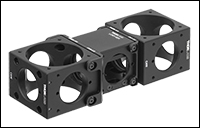
Click to Enlarge
A C4W and C6W Cage Cube connected to a 1.5" wide CCM1-4ER Compact Cage Cube using the C4W-CC and CM1-CC Cube Connectors, respectively.
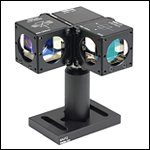
Click to Enlarge
CM1-CC Connecting Multiple 1.5" Wide Cage Cubes
- Connect Two 1.5" Wide Cage Cubes Side by Side
- Connect a 1.5" Wide Cage Cube to a 2" Wide Cage Cube
- Compatible with CM1 or CCM1 Series Cage Cubes
The CM1-CC cage cube connector allows two or more CM1 or CCM1 style cubes to be connected as shown in the image to the right. The CM1 and CCM1 series of cage cubes, which are all compatible with this connector, include empty cubes, empty dichroic cubes, mounted beamsplitters, mounted penta prisms, and mounted turning mirrors. The CM1-CC cage cube connector includes four 4-40 button-head screws, two 4-40 flat-head screws, four washers, and a 1/16" hex key.
Two cage cube-mounted turning mirrors cannot be connected using the CM1-CC due to a lack of Ø6 mm cage rod holes on two sides of the cube.
We also offer the C4W-CC to connect two 2" wide 30 mm cage cubes. Both C4W-CC and CM1-CC cage cube connectors can be used to connect one 1.5" wide 30 mm cage cube, such as our CCM1-4ER(/M), with a 2" wide 30 mm cage cube.
Alignment Pins
Please note that because dowel alignment pins are used, the connector requires drilled holes on the cube face between the SM1-threaded (1.035"-40) ports. If you have an older cube and would like it updated to have alignment holes for free, please contact Technical Support. Alternatively, the alignment pins are press-fit inside their mounting holes, and can be pressed out for use with cubes that do not have these alignment holes.
 Products Home
Products Home












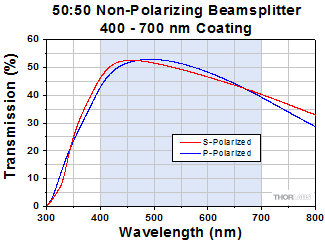
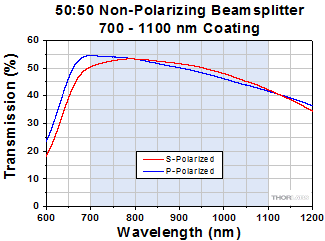
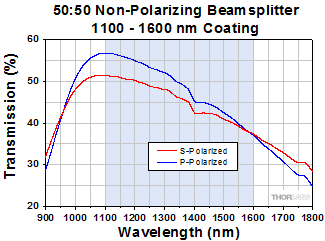

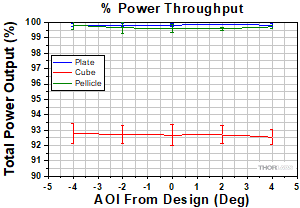
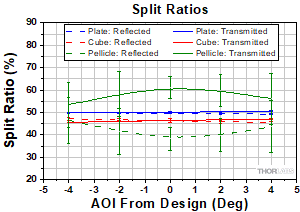
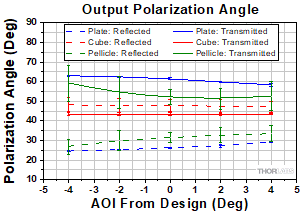

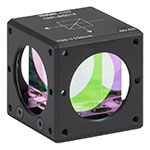
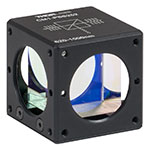
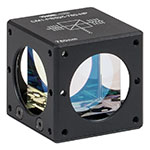
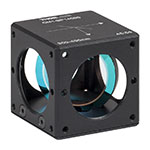
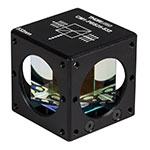
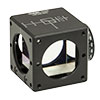
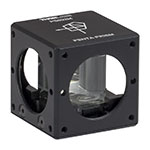
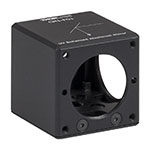
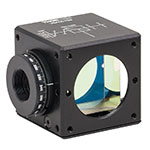

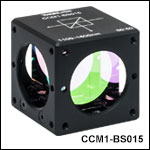
 Zoom
Zoom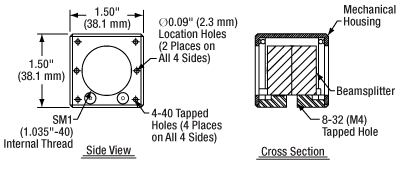
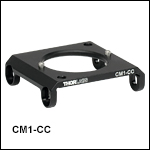
 30 mm Cage, Mounted Beamsplitter Cubes
30 mm Cage, Mounted Beamsplitter Cubes